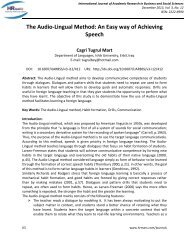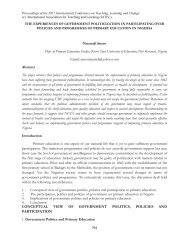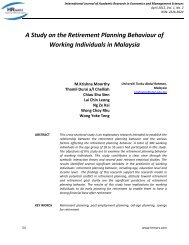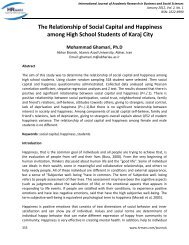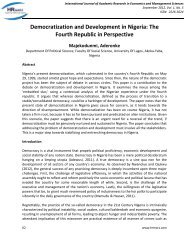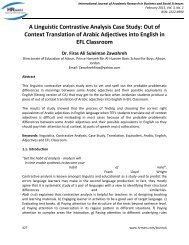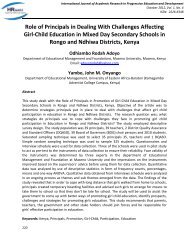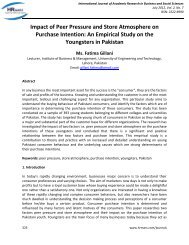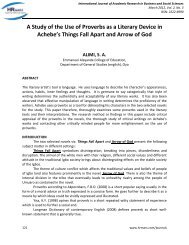Competency based Job Analysis - Human Resource Management ...
Competency based Job Analysis - Human Resource Management ...
Competency based Job Analysis - Human Resource Management ...
Create successful ePaper yourself
Turn your PDF publications into a flip-book with our unique Google optimized e-Paper software.
International Journal of Academic Research in Accounting, Finance and <strong>Management</strong> Sciences<br />
Vol. 3, No.1, January 2013, pp. 105–111<br />
ISSN: 2225-8329<br />
© 2013 HRMARS<br />
www.hrmars.com<br />
<strong>Competency</strong> <strong>based</strong> <strong>Job</strong> <strong>Analysis</strong><br />
Naveed SAIF 1<br />
Muh Saqib KHAN 2<br />
Khalid REHMAN 3<br />
Shafiq ur REHMAN 4<br />
Zia-Ur-REHMAN 5<br />
Tufail NAWA 6<br />
Muh NAQEEB 7<br />
1,2,3,6 Department of Business Administration, Gomal University, Dera Ismail Khan, Pakistan<br />
1 Email; naveedsaif_naveedsaif@yahoo.com, 2 Email; saqiblecturer@gmail.com,<br />
3 Email; khalidrehman08@gmail.com, 6 Email; tufail.nawaz@gmail.com<br />
4 University of Malakand (UOM), Pakistan, 4 Email; Shafiquol@hotmail.com<br />
5 Qurtaba, University Dera Ismail Khan Campus ,Pakistan , 5 Email: Zr.babar@gmail.com<br />
7 Agriculture University Peshawar, PKP, Pakistan<br />
Abstract The study was conducted in March 2010 at Bank of Khyber Main Head office, Peshawar with an<br />
object to assess competency <strong>based</strong> job performance. A stratified random sample of 60 employees<br />
from a total of 200 employees was taken for this study. Out of which 9 respondents were from top<br />
level, 36 from middle level and 15 respondents were from lower level of management. <strong>Competency</strong><br />
of the respondents was judged in term of knowledge, skill and attitude using Likert scale. Further, a<br />
chi-square test was used to assess the association between competency (knowledge, skill, and<br />
attitude), job analysis and performance. The estimated results showed that performance and job<br />
satisfaction were strongly associated. Similarly knowledge (shared and priorities) and skill (training<br />
and willingness) were strongly associated with job performance. However, attitude (tolerated and<br />
productive) of the respondent were insignificantly associated with job performance. Finally, it is<br />
recommended that organization may focus on knowledge, skill and particularly on attitude by<br />
arranging training to improve performance level of the respondents.<br />
Key words <strong>Competency</strong>, job performance, knowledge, performance, training<br />
1. Introduction<br />
<strong>Competency</strong> is the combination of knowledge, skills, abilities, values and interest. The use of the<br />
term competency as applied to the world of work is most commonly thought to have been first used by<br />
David McClelland, a psychologist in the early 70s. At that time, he argued that conventional tests of<br />
intelligence and abilities did not predict job performance or success in life and that they were biased<br />
against different groups. He invited the term competencies to overcome these defects, suggesting that they<br />
made possible the development of valid and unbiased predictors of performance. His approach included<br />
interviewing superior performers, identifying what they did differently from average performers and using<br />
the competencies identified for selection purposes. Competencies included motivation such as<br />
achievement, orientation, traits and specialized knowledge or skills McClelland Company, McBer eventually<br />
became part of a large human resource consulting firm. A number of prominent speakers on the subject of<br />
competencies, including Lyle Spencer and Richard Boyzatis, have their roast in the Mcbers work.<br />
Knowledge is defined variously as expertise, and skills acquired by a person through experience and<br />
education. The theoretical or practical understanding of a subject, what is know in a particular field or in
International Journal of Academic Research in Accounting, Finance and <strong>Management</strong> Sciences<br />
Vol. 3 (1), pp. 105–111, © 2013 HRMARS<br />
total, facts and information or awareness or familiarity gained by experience of fact or situation.<br />
Philosophical debates in general start with Plato's formulation of knowledge as justified true belief. 7'here<br />
is however no single agreed definition of knowledge presently or any prospect of one and there remain<br />
numerous competing theories.<br />
Skills are the practice of understanding, developing and deploying people and the skills. Well<br />
implemented skills management should identify the skills that jobs roles require, the skills of individual<br />
employees, and any gap between the two. The skills involved can be defined by the organization<br />
concerned, or by third party institution. They are usually defined in terms of a skills framework, also known<br />
as a competency framework or skills matrix. This consists of a list of skills, and a grading system, with a<br />
definition of what it means to be a particular level for a given skill. To be most useful, skills management<br />
need to be conducted as an ongoing process, with individual.<br />
1.1. <strong>Job</strong> analysis<br />
<strong>Job</strong> analysis is the basic and important part of human resource management (HRM). It covers the job<br />
analysis activity under the sub process of human resource planning. <strong>Job</strong> analysis is conducted after workforce<br />
analysis and availability analysis, (Hellriegel and Slocum Jr. 1993). It also indicates what activities and<br />
accountabilities the job entails. It is an accurate recording of the activities involved. Every job is<br />
multifaceted and there are several methods in preparing job analysis. Most organizations prepare job<br />
analysis, statements of performance and expectations of employee at floor and at the managerial level. The<br />
content of these statements varies considerably from one company to another, depending in large part on<br />
the uses to which the information is put.<br />
People performing a job may be observed and questioned. Various training manuals and other jobrelated<br />
materials may be made available to job holders, supervisors, and others who are knowledgeable<br />
may be interviewed or asked to complete written questionnaires. On occasion, photographs and films of<br />
the work, examination of tools and equipment, and actual performance of the job by a job analyst.<br />
1.2. Background of the study<br />
<strong>Job</strong> analysis is a term used by human resource managers for the processes of collecting information<br />
related to job contents. Schuman and AhJburg (1994) compared tasks performed on the job with<br />
knowledge, skills and abilities of the jobholders. The information provides job description that becomes<br />
summary report of each job in the organization. <strong>Job</strong> descriptions are the basic inputs to job evaluation,<br />
which are used to assess the characteristics along with the working conditions of each job by assigning<br />
numerical points to the duties, responsibilities and efforts required for each job. This numerical score (job<br />
points) measures the relative value of each job lo the organization (Sehuman et. al., 1994).<br />
A job analysis provides an objective picture of the job, not the person performing the job, and as<br />
such, provides fundamental information to support all subsequent and related HR activities, such as<br />
recruitment, training, development, performance management and succession planning. <strong>Job</strong> analysis<br />
serves two critical functions with respect to these processes. <strong>Job</strong> analysis helps ensure that decisions made<br />
with respect to HR processes are good decisions, i.e. fair and accurate (e.g. selection of the right person for<br />
the job, appropriate decisions about training, performance management, development, etc) and it helps<br />
ensure the defensibility of decisions made to employees (resulting in good HR management) and to the<br />
court (resulting in savings of costs, time and reputation). <strong>Job</strong> analysis provides information about jobs<br />
currently being done and the knowledge, skills and abilities that individuals need to perform the jobs<br />
adequately. It involves the identification and description of what is happening on the job accurately and<br />
precisely identifying the required tasks, the knowledge and the skills necessary and the conditions under<br />
which these duties are performed. An important concept of job analysis is that analysis is conducted of the<br />
job not of the person. People performing a job may be observed and questioned.<br />
1.3. Statement of the problem<br />
<strong>Job</strong> analysis practices are not meticulously followed in the organization, which subsequently creates<br />
problems for the organization. Many employees are inducted in the organizations which do not comply<br />
106
International Journal of Academic Research in Accounting, Finance and <strong>Management</strong> Sciences<br />
Vol. 3 (1), pp. 105–111, © 2013 HRMARS<br />
with the skills required and therefore the efficiency and effectiveness of the employees result decreased.<br />
So with this point of view the following study was designed to determine the gaps between and to<br />
improving the system.<br />
1.4. Objectives of the study<br />
1. To evaluate the competency (knowledge, skill and attitude) of the employees.<br />
2. To study the relationship between competency of employee and job performance.<br />
3. To suggest policy recommendations <strong>based</strong> on findings of the study.<br />
2. Literature review<br />
Hack man and Oldham (1975) developed a job design theory with 5 core job characteristics: skill<br />
variety, task identity, task significance autonomy and feed back. These job characteristics give rise to<br />
corresponding critical psychological states experienced by the employees. Skill variety, task identity and<br />
task significance together lead to feelings "experienced meaningfulness, autonomy leads to experienced<br />
responsibility and job feedback leads to knowledge of results. Peter (1979) article is concerned with the<br />
research results of a study, which investigated the perceived job satisfaction of personnel in the volunteer<br />
section. A comparative analysis with other selected occupational groups is also provided. Data were<br />
collected via a job satisfaction questionnaire, which allowed the investigator to determine the perceived<br />
deficiency on particular need items. Average satisfaction scores for personal in the volunteer sector were<br />
lower on almost ever need when compared with other occupational groups. Reasons are presented in an<br />
attempt to explain the results.<br />
Stewart and Rosemary (1982) worked on a model having for understanding managerial jobs and<br />
behavior was convinced in one study and developed and applied in 3 others. Some forms of flexibility are<br />
common to many managerial jobs. The need is to move on form mint bergs (1973) roles and propositions<br />
about managerial work to an analysis that takes into account the variations in behavior and the differences<br />
in jobs before attempting to generalize the managerial work. Gist and Marilyn (1987) described that self<br />
efficacy (ones capability to perform a task) affects task effort, persistence, expressed interest and the level<br />
of goal difficulty selected for performance. Despite this, little attention has been given to its organizational<br />
implications. He reviewed the self efficacy concept and then explores its theoretical and practical<br />
implications for organizational behavior and human resource management.<br />
3. Methodology of research<br />
In this chapter presents the results of the analysis conducted in the light of objectives outlined for<br />
the study Necessary discussions have also been added along with findings at appropriate places.<br />
3.1. Population and sample size<br />
There were 20 commercial banks in district Peshawar. Due to time and financial constraints the Bank<br />
of Khyber was purposively selected for this study. There were 36 branches of Bank of Khyber in Khyber<br />
Pakhtunkhwa. Out of which 15 branches were working in District Peshawar. Keeping in view the objectives<br />
and limitations of the study the Bank of Khyber Main Head office was selected for data collection purpose.<br />
There were 200 total employees in Main Head office. Out of total 30 employees were in top level<br />
<strong>Management</strong>, 120 in Middle level and 50 employees were from lower <strong>Management</strong>. A sample of size 60<br />
respondents was selected using the following stratified random sampling procedure.<br />
Using stratified random sampling, N the Break up of the employees was as under.<br />
Table 1. <strong>Management</strong> wise sample distribution of the respondents<br />
Category Number of Employees Ni Stratified random sample<br />
Top level Managers 30 9<br />
Middle level staff 120 36<br />
Lower level staff 50 15<br />
Total numbers of employees 200 60<br />
107
International Journal of Academic Research in Accounting, Finance and <strong>Management</strong> Sciences<br />
Vol. 3 (1), pp. 105–111, © 2013 HRMARS<br />
108<br />
3.2. Theoretical framework. <strong>Competency</strong> variables<br />
Knowledge is an important aspect of job and majority of people believe that they have full<br />
understanding of their jobs until they are asked to fully explain it. This module sets out to examine<br />
employee professional, specialist or expert knowledge and understanding that are specially required for a<br />
job. It is this type of expertise that combine with an employee knowledge and understanding in relation to<br />
job objective, priorities, authorities limits, resources and time to form the focus of achieving good results.<br />
The employee must have theoretical and practical understanding of subject.<br />
Acquisition of skills is important for an employee to perform a job. Every employee is looking for a<br />
specific set of skills from job seekers that match the skills necessary to perform a particular job.<br />
Communication skills are the ability to listen, write and speak effectively. Successful communication is<br />
important while performing job. Computer skills such as hardware, software, word processing and so many<br />
other tools are necessary. Leadership also deals with employee ability and hence employee must have<br />
leadership skills. Three managerial skills are essential to successful management, technical skills, human<br />
skills and conceptual skills. Attitude is a mental position consisting of a feeling, emotion or opinion evolved<br />
in response to an external situation. An attitude can be momentary or can develop into a habitual position.<br />
Employee shows different position either positive views, negative views or neutral views. Emotions are the<br />
attitude which may be shown as positive or negative. Employee performing a task may show negative<br />
attitude which falls bad impression on the organization.<br />
3.3. Data collection tools<br />
The primary data were collected through well structured questionnaires (Annexure-l) that include<br />
questions assessing various demographic and background characteristics of competency and job analysis of<br />
the respondents. The later portion of the questionnaire consisted of 20 Likert-styled items, (e.g. 1 =<br />
disagree, 2 = undecided, Schirmer et. al., (2005) stated that the actual number of choices on Likert scale<br />
may be left to the tastes of the individual researchers. In practice researchers often do assign the number<br />
of arbitrary choices according to the personal taste or past convention. So for this study three alternative<br />
choices (as mentioned above) were assigned on Likert scale.<br />
3.4. Data analysis<br />
Data collected through questionnaire were analyzed using a statistical package for social sciences<br />
(SPSS) version 16. Sometimes, the actual measurements or counts of individual or subjects were either not<br />
available or accurate assessment was not possible. They are then arranged in order according to some<br />
characteristics of interest. Such an order given to an individual or object is called its ranks. But only Likert<br />
scale was used in the present study in collecting the required information. All the results were presented in<br />
counts and percentages in different tabular form under the needed sections. In order to test the<br />
association between different variables/attributes a Chi-square test was applied at 5% level of significance.<br />
In addition to the Chi-square test, appropriate statistical measures were also applied for addressing<br />
the major findings of the research.<br />
4. Results and discussions<br />
The results of the data analysis conducted in the light of objectives outlined for the study necessary<br />
discussions have also been added along with findings at appropriate places.<br />
4.1. Distribution of respondents<br />
The information regarding different characteristics of the sampled respondents of the Bank of Khyber<br />
(BOK) are given in table 2. The male respondents were 48 and the remaining 12 were female. Maximum<br />
respondents were on ad-hoc basis that were 35. Limited numbers (6) were on contract while 19 were<br />
permanent employees, ft was also revealed that showed the educational level of the respondents that they<br />
achieved during their careers were MBA degree holders were 25, BBA 6, MA 9, BA 5, M.COM 10, and<br />
B.COM 5. Ages of the respondents were in the range of 28 to 50 years.
International Journal of Academic Research in Accounting, Finance and <strong>Management</strong> Sciences<br />
Vol. 3 (1), pp. 105–111, © 2013 HRMARS<br />
Table 2. Distribution of Sampled Respondents<br />
Variable No. of responds Percentage<br />
Gender<br />
Male 48 80<br />
Female 12 20<br />
Total 60<br />
Mode of job<br />
100<br />
Ad-hoc 35 58.3<br />
Permanent 19 31.7<br />
Contract 6 10<br />
Total 60<br />
Qualification<br />
100<br />
Post Graduate (Master) 44 73.33<br />
Graduate (Bachelor) 16 26.66<br />
Total 60<br />
Ages<br />
100<br />
Ages from 28 to 39 40 66.66<br />
Ages from 40 to 50 20 33.33<br />
1 or less than 1: Unfavorable attitude of the respondents towards the given statements<br />
1 to 2: Neutral attitude/undecided<br />
2 to 3: Favorable attitude<br />
Table 3. Descriptive summary of various attributes of the sampled respondents<br />
Attributes Minimum Maximum Mean<br />
Shared 1.00 3.00 2.4667<br />
Priorities 1.00 3.00 2.3833<br />
Measurements 1.00 3.00 2.4833<br />
Training 1.00 3.00 1.9500<br />
Willingness 1.00 3.00 2.4500<br />
Proficiency 1.00 3.00 1.7833<br />
Self confidence 1.00 3.00 1.7000<br />
Drastically 1.00 3.00 2.4000<br />
Tolerated 1.00 3.00 1.6000<br />
Productive 1.00 3.00 1.5667<br />
Destiny 1,00 3.00 2.5167<br />
Exposure 1.00 3.00 2.2833<br />
Decreasing 1.00 3.00 2.4167<br />
Autonomy 1.00 3.00 2.2667<br />
Where: 1 = disagree; 2 = undecided; 3 = agree might believe that they have authority somewhat<br />
equal to that of their' boss. Finally it is concluded that too much autonomy may reduce productivity.<br />
Table 4. Response regarding employee dissatisfaction regarding autonomy<br />
Category Numbers Percentage<br />
Disagree 19 31<br />
Undecided 6 10<br />
Agree 35 59<br />
Total 60 100<br />
109
International Journal of Academic Research in Accounting, Finance and <strong>Management</strong> Sciences<br />
Vol. 3 (1), pp. 105–111, © 2013 HRMARS<br />
110<br />
4.2. Association between knowledge and job analysis<br />
Data pertaining to the association between knowledge and job analysis are displayed in table 5. The<br />
results indicated a significant (P
5.3. Recommendations<br />
International Journal of Academic Research in Accounting, Finance and <strong>Management</strong> Sciences<br />
Vol. 3 (1), pp. 105–111, © 2013 HRMARS<br />
Based on findings, the following recommendations are forwarded:<br />
1. Performance and skill were strongly correlated with job analysis, so<br />
2. Organization may work on these factors in order to enhance job analysis.<br />
3. Organization may focus on the knowledge, skills and attitude and can arrange training for the<br />
employees to increase the motivation.<br />
4. Training and employees willingness are associated with each other this reflects that management<br />
need to train employees to enhance organization commitment.<br />
5. Organization need to appraise employee’s performance against the standard and may consider<br />
knowledge, skills and attitude as key performance indicators.<br />
References<br />
1. Alan, M. Sacks and David, A. Waldman (1998). The relationship between age and job performance<br />
evaluations for entry level professionals, the journal of <strong>Human</strong> <strong>Resource</strong>s. 19(4): 409419.<br />
2. Alison, Barber, E. Mark and Roehling V. (1993). <strong>Job</strong> postings and the decision to interview: A<br />
verbal protocol analysis. Journal of Applied Psychology. 78 (5): 845-856.<br />
3. Burnet, J. (2007). An <strong>Analysis</strong> of employee recognition: Perspective on human resources<br />
practices. The International Journal of <strong>Human</strong> <strong>Resource</strong> <strong>Management</strong>. Volume 19, pp. 716-730.<br />
4. Day V, David and SUverman, B. Stanley (2006). Personality and job performance, Evidence of<br />
Incremental Validity. 42(1); 25-36.<br />
5. Francis, J. Yammarino and David A. Waldman (1993). Performance in relation to job skill<br />
importance: A consideration of rater source. Journal of Applied Psychology. 78 (2): 242-249.<br />
6. Gist and Marilyn 1987. Implication for organizational behavior and human resource management,<br />
The Academy of <strong>Management</strong> Review.12 (3): 472-485.<br />
7. Hack man, J. and Otdham (1975). Development of job diagnostic survey, Journal of Applied<br />
Psychology. 60, 159-170.<br />
8. Lawler, E. Edward (1994). From job <strong>based</strong> to competency <strong>based</strong> organizations, Journal of<br />
Organizational Behavior. 15(1): 3-15.<br />
9. Mansfield, S. Richard (1998). Building competency models: Approaches for HR professionals.<br />
Journal of <strong>Human</strong> <strong>Resource</strong> <strong>Management</strong>. 36(1 ): 7-18.<br />
10. Neuman A. George, Wagner H. Stephen and Christiansen D. Neil (1999). The relationship<br />
between work team personality composition and the job performance of teams, Journal of<br />
Organizational Behavior. 24(1): 28-45.<br />
11. PauL R-SadkOL Meicssa. L. Gruys. Jill and E. EUingson (1998). Ability personality interactions when<br />
predicting job performance. Journal of Applied Psychology. ft4i: 545-556.<br />
12. Peier. T. (1979). A comparative analysis of job satisfaction. The Official Journal of the National<br />
Network for Social Work Managers. 3, 193-206.<br />
13. Rodriguez, D. Patel R. and B, Andrea (2002). Developing competency models to promote<br />
integrated human resource practices. Office of Personnel <strong>Management</strong>, 41,(2):309-324.<br />
14. Schumann, Paul L. and Ahlburg (1994). The effect of human capital and job characteristics on<br />
pay. The Journal of <strong>Human</strong> <strong>Resource</strong>s. 29(2): 481 -503.<br />
15. Simons and Robert (2005). Designing high performance jobs. Harvard Business Review, Business School<br />
Press, pp, 55-62.<br />
16. Somers, J. (1998). Work related commitment and job performance. It's also the nature of the<br />
performance that counts, The Journal of Organizational Behavior. 19 (6): 621-634.<br />
17. Stewart, and Rosemary (1982). A model for understanding managerial jobs and behavioral, The<br />
Academy of <strong>Management</strong> Review. 7(1): 7-13.<br />
18. Susan, J. and Patrick (2006). Adopting job analysis methodology to improve evaluation practice,<br />
American Journal of Evaluation. 27 (4): 485-494.<br />
19. Taber, D. and Peters, D (1991). Assessing the completeness of a job analysis procedure. Journal of<br />
Organizational Behavioral. 12(1): 581-593.<br />
111



